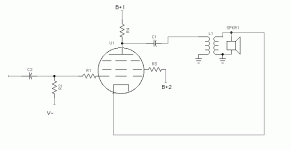I have seen it touched on in a few places... old tube texts and a fwe forums... including the cumbersome Bottlehead old school BBS style "forum," but nothing detailed. There was that ne article about the mathematical derivision of the parafeed that was good, but for choke loads. I was just wondering if anyone had some tweaking tips or personal experience.
Anyway, I built one the other day... an SE el34 in pentode mode with a plate resistor of a few k (i tried between 1k and 4k, and likes 1.5k the best) and varying transformer loads between 2K-5k (i liked the lower loads the best, 2.5k or so). Then I a/b'd it with a 50H plate choke, and regulated the B+ down to match the plate voltage of the resistor loaded stage ( around 350v) the screens in both configurations were mosfet regulated to 340v or so, and the bias was fixed, and adjusted for 80-90% plate dissapation.
I measured about 1-1.5w (give or take) from the RC stage, and about 7-8w from the choke loaded version. I used a 400Hz sine generator ( and just turned it up until i heard distortion, then backed it off) and an AC RMS meter across an 8r dummy load, so those numbers are not very accurate probably... but I just wanted a general idea.
Other than the dramatic drop in output from the resistor version... it sounded much much better. I used the same 5.1uF film/foil coupling capacitor from the plate in both cases, into a Hammond SE tranny. I also ran the cathode through the secondary for a bit of NFB... not very high tech, but it gave the bass a nice little boost.
It was just fed from a 12ax7 driver/follower. I listened to a bit of music through it, and a Monty Python movie, and really dug the sound (as much as you can dig mono that is). Honestly, it blew away my freewired Gainclone, and the Samson Servo reference amp that I use... not NEARLY as flat or deep in the bass, but sweeter.
THEN I hooked up a Soldano preamp to the thing and waled away through it on my guitar for a while (of course I did... it's ME) through a guitar speaker cabinet... and that sounded really nice too. it had a sweet spongy overdriven tone that was a BIT lacking in the bass, but it was nice anyway for a 1 watt amp... and LOUD (my guitar cab is a 2x12" with 102dB sensitivity).
Anyway, I built one the other day... an SE el34 in pentode mode with a plate resistor of a few k (i tried between 1k and 4k, and likes 1.5k the best) and varying transformer loads between 2K-5k (i liked the lower loads the best, 2.5k or so). Then I a/b'd it with a 50H plate choke, and regulated the B+ down to match the plate voltage of the resistor loaded stage ( around 350v) the screens in both configurations were mosfet regulated to 340v or so, and the bias was fixed, and adjusted for 80-90% plate dissapation.
I measured about 1-1.5w (give or take) from the RC stage, and about 7-8w from the choke loaded version. I used a 400Hz sine generator ( and just turned it up until i heard distortion, then backed it off) and an AC RMS meter across an 8r dummy load, so those numbers are not very accurate probably... but I just wanted a general idea.
Other than the dramatic drop in output from the resistor version... it sounded much much better. I used the same 5.1uF film/foil coupling capacitor from the plate in both cases, into a Hammond SE tranny. I also ran the cathode through the secondary for a bit of NFB... not very high tech, but it gave the bass a nice little boost.
It was just fed from a 12ax7 driver/follower. I listened to a bit of music through it, and a Monty Python movie, and really dug the sound (as much as you can dig mono that is). Honestly, it blew away my freewired Gainclone, and the Samson Servo reference amp that I use... not NEARLY as flat or deep in the bass, but sweeter.
THEN I hooked up a Soldano preamp to the thing and waled away through it on my guitar for a while (of course I did... it's ME) through a guitar speaker cabinet... and that sounded really nice too. it had a sweet spongy overdriven tone that was a BIT lacking in the bass, but it was nice anyway for a 1 watt amp... and LOUD (my guitar cab is a 2x12" with 102dB sensitivity).
Attachments
I played with this idea a few years ago. The plate load resistor is effectively in parallel with the output transformer for AC. This is where your missing output power went. After playing with this idea, I graduated to CCS loaded output stages. The missing power comes back and some of the efficiency returns. They sound great with a triode but I never tried a CCS with a pentode.
If I remember right, I got the idea from Steve Bench's web site, perhaps the results of his experiments are still on his site.
I found them they are here:
http://members.aol.com/sbench/outstru.html
If I remember right, I got the idea from Steve Bench's web site, perhaps the results of his experiments are still on his site.
I found them they are here:
http://members.aol.com/sbench/outstru.html
- Status
- Not open for further replies.
